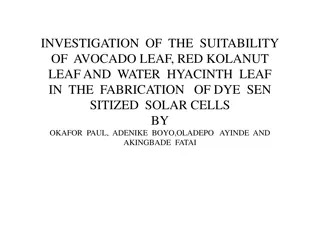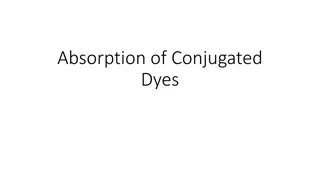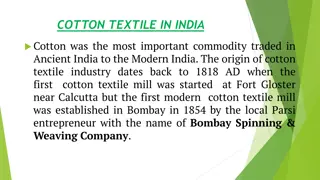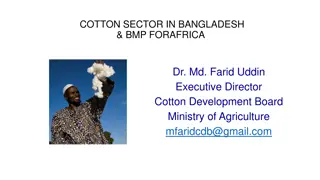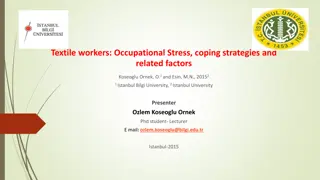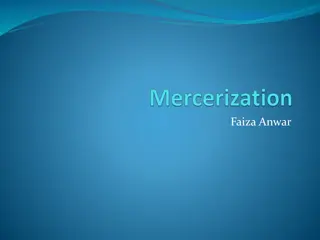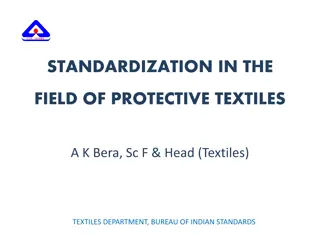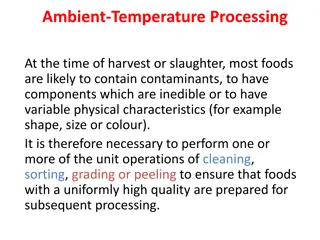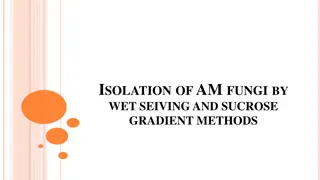Exploring Natural Dyes in Textile Wet Processing
Natural dyes, sourced from plants, minerals, and animals, have made a resurgence in textile dyeing due to environmental concerns. This online class covers the origin, classification, and characteristics of natural dyes such as Indigo, Indian Madder, Turmeric, Marigold, Henna, Tea, and Onion. Discover the vibrant world of eco-friendly dyeing practices and their applications in the textile industry.
Download Presentation

Please find below an Image/Link to download the presentation.
The content on the website is provided AS IS for your information and personal use only. It may not be sold, licensed, or shared on other websites without obtaining consent from the author. Download presentation by click this link. If you encounter any issues during the download, it is possible that the publisher has removed the file from their server.
E N D
Presentation Transcript
SUBJECT : TEXTILE WET PROCESSING CLASS : II BSc CDF UNIT - 4 1
Onlineclass(Googlemeet) Prepared by : V.Deepa Class: II.B.Sc CDF 16/09/2021 DYES Natural Dyes Natural dyes are colour substances obtained from natural sources. Natural dyes are used for all types of textile dyeing and printing until the middle of nineteenth century. The use of natural dyes were reduced due to the advent of synthetic dyes, though they were economical and posses excellent fastness properties. However, the growing consumer awareness on the harmful impact of synthetic dyes, concern for environment worldwide and stringent environmental laws lead to the revival of natural dyes. Natural dyes are dyes or colorants derived from plants,minerals. The majority of natural dyes are vegetable dyes from plant sources roots,berries,bark,leaves, and wood and other biological sources such as fungi. 2
Onlineclass(Googlemeet) Prepared by : V.Deepa Class: II.B.Sc CDF 16/02/2021 Classification of Natural Dyes Natural dyes are classified in to three types based on the source of origin namely vegetable dyes, animal dyes and mineral dyes. 1.Vegetable Dyes The earliest dyes were of vegetable origin, discovered by accidentally staining garments with juices of fruits or plants. Vegetable dyes are obtained from different parts of plants such as leaves, flowers, fruits, pods, bark etc. These vegetable dyes can be applied directly or with different mordants. Indigo:Indigo (blue dye) is called as the king of all natural dyestuffs. It imparts blue colour. It is extracted from the leaves of the leguminous plant,Indigofera tinctoria. It is suitable for dyeing cotton and wool. 3
Onlineclass(Googlemeet) Prepared by : V.Deepa Class: II.B.Sc CDF 16/02/2021 Indian Madder:It produces shades of red on textile fabrics. It is used for dyeing cotton and woollen fabrics. It is extracted from roots of Rubia tinctoria. Turmeric:It produces shades of yellow on fabrics. It is suitable for dyeing cotton, silk and wool. The yellow dye is extracted from the ground root (rhizome) of turmeric plant (Curcuma longa). Marigold:It is extracted from lemon or orange coloured marigold (Calendula officinalis) flower. It is suitable for dyeing both silk and wool fibres. Henna:The dye is extracted from the dried leaves of Henna plant,Lawsonia inermis. It produces yellowish orange colour. It is suitable for dyeing wool and silk fibres. 4
Onlineclass(Googlemeet) Prepared by : V.Deepa Class: II.B.Sc CDF 16/02/2021 Tea: Leaves of tea plants (Camellia sinensis) or tea powder is used to extract dye. It produces different shades of brown. Onion: The dye is extracted from the outer most skin or peel of the onion (Allium cepa). The onion skins if properly dried can be used for one year. 2.Animal Dyes Dyes extracted from certain insects and invertebrates are called as animal dyes. Various shades of red and purple were obtained from animal origin. Cochineal, Tyrian purple and Lac are the commonly used animal dyes. 5
Onlineclass(Googlemeet) Prepared by : V.Deepa Class: II.B.Sc CDF 16/02/2021 1. Cochineal Cochineal dye is extracted from the dried bodies of the female red bug (Dactylopius coccus). It produces crimson and scarlet colours with mordants aluminium and tin oxide. This dyestuff was mostly used for dyeing wool and silk. These dyes exhibit excellent fastness properties. 2. Tyrian Purple This dye is extracted from the sea snails found in Mediterranean Sea. The amount of dye produced was very limited and therefore very expensive. Hence, it is called Royal purple. 6
Onlineclass(Googlemeet) Prepared by : V.Deepa Class: II.B.Sc CDF 16/02/2021 3. Lac Dye This dye is extracted from the fluid secreted by the lac insect (Lauifer lacca), which lives on the twigs of the banyan trees and other varieties. It produces crimson and scarlet colours. These dyes possess good fastness to light and washing. Animal dyes are also obtained from murex snail (purple colour) and Octopus/ Cuttle fish (Sepia brown) 3.Mineral Dyes Dyes extracted from mineral sources are called as mineral dyes. Most widely used mineral dyes are Iron, which produces yellowish brown shades, chrome yellow, prussian blue and manganese brown. The dyes obtained from mineral sources may be poisonous and hence are not being used commercially. 7
Onlineclass(Googlemeet) Prepared by : V.Deepa Class: II.B.Sc CDF 16/02/2021 Uses of Natural Dyes in Textile Fashion Due to the different molecular structure, different mordant treatments are required to prepare cellulose and protein fibers for natural dyes. Cellulose fiber: Cotton, Linen, Flax, Bamboo, Rayon etc. Protein fiber:Wool, Angora, Mohair, Kashmir, Silk, Leather etc. Cellulose fibers have less affinity for natural dyes than protein fibers.The most common method of preparing cellulose fibers is to use Tannin first, then use Aluminum metal salts.The most common method of preparing protein fiber is to use Alum. 8
Onlineclass(Googlemeet) Prepared by : V.Deepa Class: II.B.Sc CDF 16/09/2021 Below are some of the important and common natural dyes that are widely used for dyeing textile materials (fiber, yarn, cloth). Jack Fruits The wood of the jackfruit plant is finely chopped and then boiled in water to extract the dye.After the treatment of mordanting, it gives the color of the fabric from Yellow to Brown shade. It was used for dyeing cotton and jute fabrics. 9
Onlineclass(Googlemeet) Prepared by : V.Deepa Class: II.B.Sc CDF 16/09/2021 Indigo Tree Indigo dye, which is obtained from Indigofera tinctoria and gives a shade of Blue.Color is found in 0.4% of the total weight of Indigo tree.Proper reproduction of natural Indigo shades is difficult.Various natural Indigos are used to get Blue shades on cotton. It is a kind of VAT dye and therefore vatting is required for dyeing. It is known as the oldest and most widely used dye. 10
Onlineclass(Googlemeet) Prepared by : V.Deepa Class: II.B.Sc CDF 16/09/2021 Onion Skins Onion skin is the main source of dyes.It is boiled to remove the color from the onion skins and can later be dyed without mordanting the fabric.The result is a shade of Orange to Brown on the fabric. Pelargonidin is the color molecule responsible for the dye in onion skins. Madder Roots Red dye prepared from herb called Madder. Madder s color molecule is Alizarin.Cotton, Silk and Wool fibers can be dyed with Madder at a temperature of 100oC.It gives bright Red shades on wool and silk and Reddish to Purple shades on cotton. 11
Onlineclass(Googlemeet) Prepared by : V.Deepa Class: II.B.Sc CDF 16/09/2021 Tumeric Tumeric seems to be the most common dye found in nature. The Tumeric obtained from the roots of the plant is first dried, then crushed into powder and boiled with water to extract the dye. The result is a bright Yellow shade. It is commonly used for dyeing cotton, Wool and Silk.The color molecule responsible for this yellow color is Curcumin . 12
Onlineclass(Googlemeet) Prepared by : V.Deepa Class: II.B.Sc CDF 16/09/2021 Henna Leaves The leaves of the henna tree are dried and ground and then boiled with water to get the dye out of the leaves.Mordanting fabrics range in color from Brown to Mustard yellow.It is a disperse dye type color.Therefore, polyester and nylon can be dyed by henna. 13
Onlineclass(Googlemeet) Prepared by : V.Deepa Class: II.B.Sc CDF 16/09/2021 Logwood The color is extracted by boiling the stem of the Logwood tree in small pieces for an hour.Logwood is used to create Black shades on wool. Logwood trees are commonly found in Mexico, Central America and the Caribbean islands. Haematoxylin is the pigment of the Logwood natural dye. 14
Onlineclass(Googlemeet) Prepared by : V.Deepa Class: II.B.Sc CDF 16/09/2021 Lac Insects Lac dye is made from a special insect (Coccus Lacca).It mainly produces shades of Scarlet to Crimson Red.This pigment produced by insects is called stick lac. 15
Onlineclass(Googlemeet) Prepared by : V.Deepa Class: II.B.Sc CDF 16/02/2021 1. Advantages of Natural Dyes Natural dyes are extracted from natural sources and hence they are eco-friendly Produces soft and soothing colours These dyes provide excellent protection from UV rays Natural dyes like turmeric have anti-microbial properties and hence protect the fabrics and wearers from microbial attack Some natural dyes possess mosquito repellent and flame resistant property They can be obtained from the natural sources which are abundant in a particular area. Hence supply of raw materials will be continuous and transport charges will be lower 16
Onlineclass(Googlemeet) Prepared by : V.Deepa Class: II.B.Sc CDF 16/02/2021 2. Disadvantages of Natural Dyes Natural dyes are difficult to store Dye extraction is a time consuming process Reproducibility of the same colour shade is difficult Impurities in natural dyes fades away the colour produced Availability of these dyes depends on the seasons Natural dyeing process is difficult to standardize 17
Onlineclass(Googlemeet) Prepared by : V.Deepa Class: II.B.Sc CDF 16/09/2021 18








